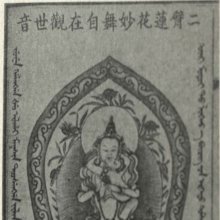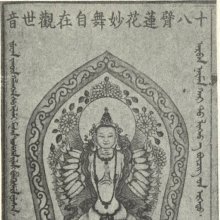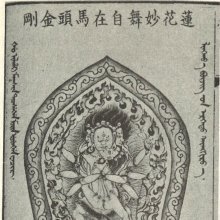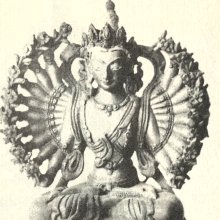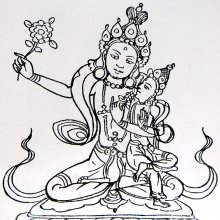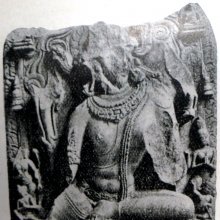Padmanarteshvara, Padmanarteśvara: 5 definitions
Introduction:
Padmanarteshvara means something in Buddhism, Pali, Hinduism, Sanskrit. If you want to know the exact meaning, history, etymology or English translation of this term then check out the descriptions on this page. Add your comment or reference to a book if you want to contribute to this summary article.
The Sanskrit term Padmanarteśvara can be transliterated into English as Padmanartesvara or Padmanarteshvara, using the IAST transliteration scheme (?).
Images (photo gallery)
(+1 more images available)
In Buddhism
Tibetan Buddhism (Vajrayana or tantric Buddhism)
Source: Wisdomlib Libary: VajrayoginiPadmanarteśvara (पद्मनर्तेश्वर) is an alternative name of Amitābha: a deity to be contemplated upon by a practicioner purifying his correspondences (viśuddhi), according to the 12th-century Abhisamayamañjarī. The contemplation is prescribed as a preliminary ritual for a yogin wishing to establish, or reestablish the union with a deity.
Padmanarteśvara is associated with the skandha named saṃjñā (cognition) and the color red. He is to be visualised as standing in the warrior (ālīḍha) stance, having three eyes, matted locks and bearing the five signs of observance (mudrā).
Source: academia.edu: A Critical Study of the Vajraḍākamahātantrarāja (II)Padmanarteśvara (पद्मनर्तेश्वर) is the husband of Mahābalā: the name of a Ḍākinī (‘sacred girl’) presiding over Sindhu: one of the four Śmaśāna (‘sacred spot’) present within the Kāyacakra (‘circle of body’) , according to the 9th-centruy Vajraḍākatantra. The Kāyacakra is one of three Cakras within the Tricakra system which embodies twenty-four sacred spots or districts resided over by twenty-four Ḍākinīs whose husbands (viz., Padmanarteśvara) abide in one’s body in the form of twenty-four ingredients (dhātu) of one’s body.
Mahābalā has for her husband the hero (vīra) named Padmanarteśvara. She is the presiding deity of Sindhu and the associated internal location are the ‘insteps’ and the bodily ingredients (dhātu) are the ‘tears’.
Source: academia.edu: A Critical Study of the Vajraḍākamahātantrarāja (I)Padmanarteśvara (पद्मनर्तेश्वर) or Vajranarteśvara is the name of a deity associated with the Skandha (component) named Saṃjñā, according to the 9th century Vajraḍākatantra chapter 1.16-22.—Accordingly, this chapter proclaims the purity of the five components (skandha), five elements (bhūta) and five senses (āyatana) as divine beings [viz., Padmanarteśvara].
Source: academia.edu: The Structure and Meanings of the Heruka Maṇḍala1) Padmanarteśvara (पद्मनर्तेश्वर) is the name of a Vīra (hero) who, together with the Ḍākinī named Mahābalā forms one of the 36 pairs situated in the Vajracakra, according to the 10th century Ḍākārṇava chapter 15. Accordingly, the vajracakra refers to one of the four divisions of the sahaja-puṭa (‘innate layer’), situated within the padma (lotus) in the middle of the Herukamaṇḍala. The 36 pairs of Ḍākinīs and Vīras [viz., Padmanarteśvara] each have one face and four arms; they hold a skull bowl, a skull staff, a small drum and a knife; they are dark-bluish-black in color.
2) Padmanarteśvara (पद्मनर्तेश्वर) is also mentioned as a Vīra (hero) who, together with the a Ḍākinī named Padmanartī (Padmanarteśvarī) forms one of the 36 pairs situated in the Hṛdayacakra, according to the 10th century Ḍākārṇava chapter 15. The 36 pairs of Ḍākinīs and Vīras [viz., Padmanarteśvara] are reddish yellow in color; they each have one face and four arms; they hold a skull bowl, a skull staff, a small drum, and a knife.

Tibetan Buddhism includes schools such as Nyingma, Kadampa, Kagyu and Gelug. Their primary canon of literature is divided in two broad categories: The Kangyur, which consists of Buddha’s words, and the Tengyur, which includes commentaries from various sources. Esotericism and tantra techniques (vajrayāna) are collected indepently.
Languages of India and abroad
Sanskrit dictionary
Source: Cologne Digital Sanskrit Dictionaries: Edgerton Buddhist Hybrid Sanskrit DictionaryPadmanarteśvara (पद्मनर्तेश्वर).—name of a deity: Sādhanamālā 75.6 et alibi.
Sanskrit, also spelled संस्कृतम् (saṃskṛtam), is an ancient language of India commonly seen as the grandmother of the Indo-European language family (even English!). Closely allied with Prakrit and Pali, Sanskrit is more exhaustive in both grammar and terms and has the most extensive collection of literature in the world, greatly surpassing its sister-languages Greek and Latin.
See also (Relevant definitions)
Full-text: Padmadaka, Padmanarteshvari, Vajranarteshvara, Amitabha, Mahabala, Padmanarti, Padmanarta, Sindhu, Vajracakra.
Relevant text
Search found 2 books and stories containing Padmanarteshvara, Padmanarteśvara, Padmanartesvara; (plurals include: Padmanarteshvaras, Padmanarteśvaras, Padmanartesvaras). You can also click to the full overview containing English textual excerpts. Below are direct links for the most relevant articles:
The Indian Buddhist Iconography (by Benoytosh Bhattachacharyya)
The gods of northern Buddhism (by Alice Getty)
Related products
